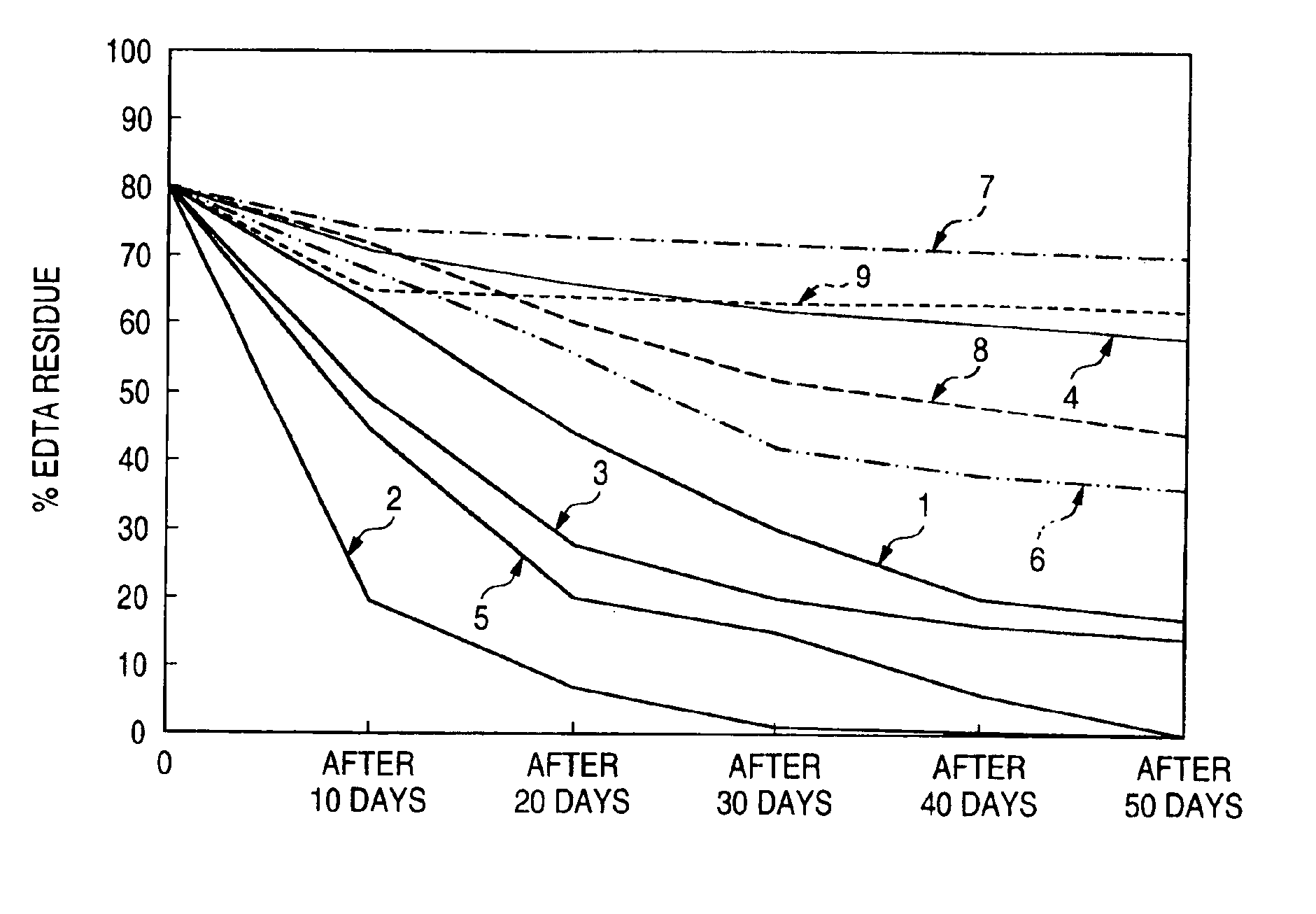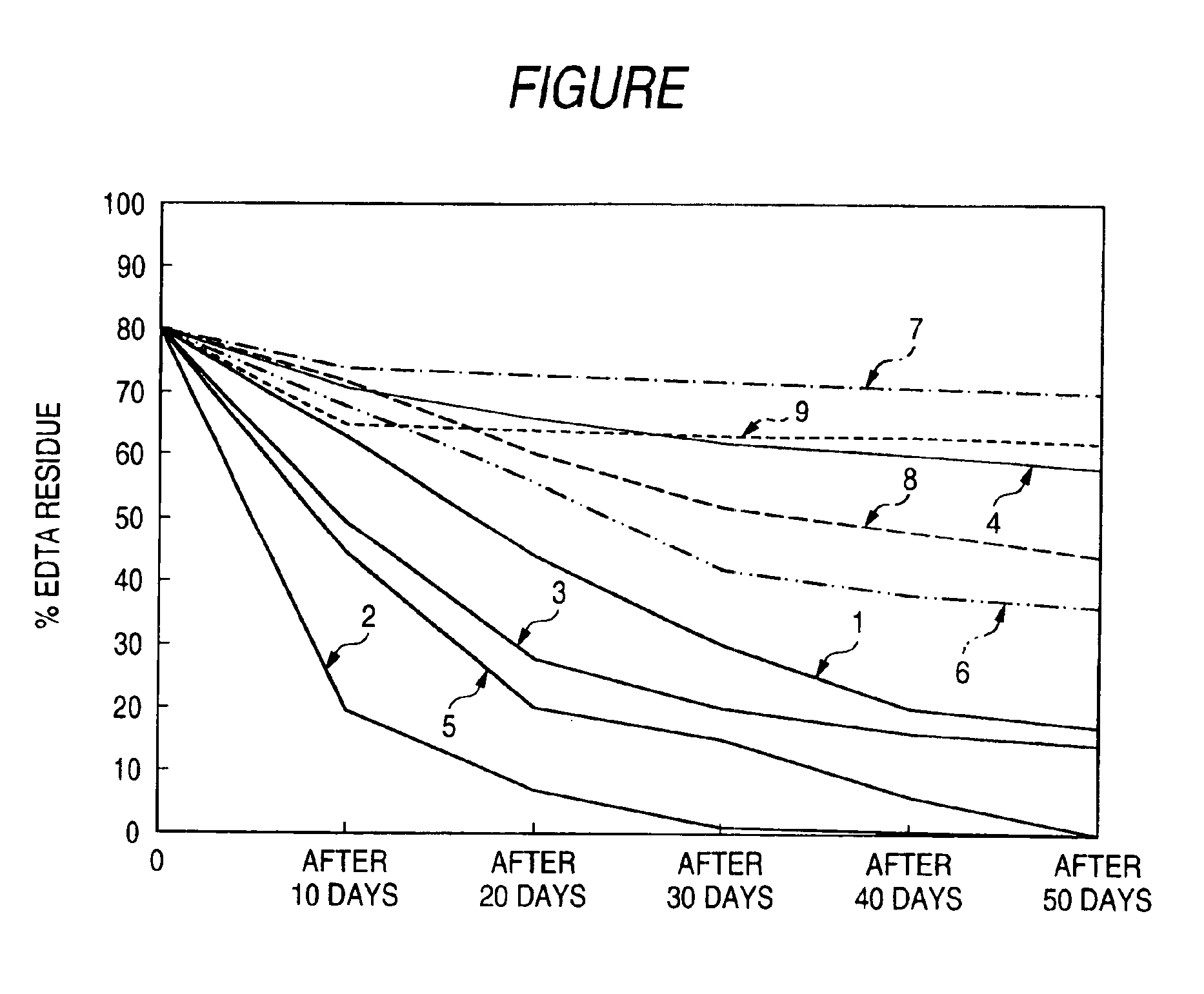Method of remedying contaminated soil by microorganism
a microorganism and soil technology, applied in microorganisms, on/in biological cells, enzymemology, etc., can solve problems such as soil contamination, serious problems, and detection of difficult to degrade harmful chemical materials in soil,
- Summary
- Abstract
- Description
- Claims
- Application Information
AI Technical Summary
Benefits of technology
Problems solved by technology
Method used
Image
Examples
example 1
[0092]1 platinum loop of an EDTA-degrading bacterium Bacillus editabidus-1 (FERM P-13449) was subjected to static culture in 200 ml of a {fraction (1 / 30)} M phosphoric acid buffering solution (pH 5.8) containing 0.5% by mass of polypeptone (produced by Kyokuto Seiyaku Co., Ltd.), 0.1% by mass of a yeast extract (produced by Wako Pure Chemical Industries, Ltd.) and 0.1% by mass of NH4Fe (III)EDTA (produced by Wako Pure Chemical Industries, Ltd.) as a basal medium at a temperature of 37° C. for 1 day to obtain a cultured product containing the bacterium in a high concentration.
[0093]The cultured product was then subjected to centrifugal separation so that it was divided into wet form of the bacterium and supernatant of cultured product. The wet form of the bacterium was then subjected three times to washing with purified water conforming the purity standard defined by the Japanese Pharmacopoeia and recovery of wet form of bacterium by centrifugal separation to obtain a washed wet bact...
example 2
[0104]The testing procedure of Example 1 was followed except that the EDTA-degrading Bacillus editabidus-1 (FERM P-13449) was replaced by an EDTA-degrading Pseudomonas editabidus-1 (FERM P-13634) described in Japanese Patent Laid-Open No. 1994-335386. The results of test made on the various samples on 9 levels of Example 2 obtained in the same manner as in 9 samples of Example 1 except that the kind of biodegrading bacteria was changed show that even if there is some difference in residual EDTA concentration among these samples, the relative difference among the 9 samples of Example 2 corresponds to the difference among the 9 samples of Example 1. In this sense, the difference among the 9 samples of Example 2 was substantially the same as that among the 9 samples of Example 1.
example 3
[0105]The testing procedure of Example 1 was followed except that the EDTA-degrading Bacillus editabidus-1 (FERM P-13449) was replaced by an EDTA-degrading Bacillus editabidus-M1 (FERM P-14868) described in Japanese Patent Laid-Open No. 1996-289778. The results of test made on the various samples on 9 levels of Example 3 obtained in the same manner as in 9 samples of Example 1 except that the kind of biodegrading bacteria was changed show that even if there is some difference in residual EDTA concentration among these samples, the relative difference among the 9 samples of Example 3 corresponds to the difference among the 9 samples of Example 1. In this sense, the difference among the 9 samples of Example 3 was substantially the same as that among the 9 samples of Example 1.
PUM
| Property | Measurement | Unit |
|---|---|---|
| Diameter | aaaaa | aaaaa |
| Diameter | aaaaa | aaaaa |
| Mass | aaaaa | aaaaa |
Abstract
Description
Claims
Application Information
 Login to View More
Login to View More - R&D
- Intellectual Property
- Life Sciences
- Materials
- Tech Scout
- Unparalleled Data Quality
- Higher Quality Content
- 60% Fewer Hallucinations
Browse by: Latest US Patents, China's latest patents, Technical Efficacy Thesaurus, Application Domain, Technology Topic, Popular Technical Reports.
© 2025 PatSnap. All rights reserved.Legal|Privacy policy|Modern Slavery Act Transparency Statement|Sitemap|About US| Contact US: help@patsnap.com


